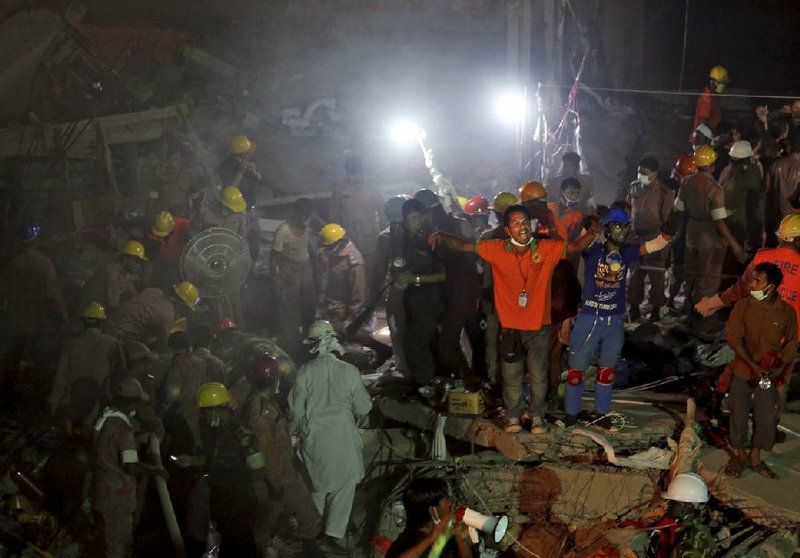SAVAR, Bangladesh - The fugitive owner of an illegally constructed building that collapsed and killed at least 377 people was captured Sunday by a commando force as he tried to flee into India. At the disaster site, meanwhile, fire broke out in the wreckage and forced authorities to suspend the search for survivors temporarily.
Mohammed Sohel Rana was arrested in the western Bangladesh border town of Benapole, said Jahangir Kabir Nanak, junior minister for local government. Rana was taken back by helicopter to the capital of Dhaka, where he faces charges of negligence.
Two associates of Rana who helped him travel to Benapole were also arrested, Mokhlesur Rahman, director general of the commando unit Rapid Action Battalion, said at a press briefing Sunday.
Rana’s capture was announced by loudspeaker at the disaster site, drawing cheers and applause from those awaiting the outcome of a continuing search-and rescue operation for survivors of Wednesday’s collapse.
Many of those killed were workers at clothing factories in the building, known as the Rana Plaza, and the collapse was the deadliest disaster to hit Bangladesh’s garment industry, which is worth $20 billion annually and is a mainstay of the economy.
The fire that broke out late Sunday night sent smoke pouring from the piles of shattered concrete and halted some of the rescue efforts - including a bid to free a woman who was found trapped in the rubble.
The blaze was caused by sparks as rescuers tried to cut through a steel rod to reach the woman, said a volunteer, Syed Al-Amin Roman. At least three rescuers were injured in the fire, he said. It forced them to retreat while firefighters frantically hosed down the flames.
Officials believe the fire is likely to have killed the trapped woman, said army spokesman Shahinul Islam. Rescue workers had delayed the use of heavy equipment for several hours in the hope that she could be extricated from the rubble first. But with the woman presumed dead, they began using heavy equipment around midnight Bangladesh time.
An exhausted and disheveled Rana was brought before reporters briefly at the Dhaka headquarters of the Rapid Action Battalion.
Wearing a printed shirt, Rana was sweating as two security officers held him by his arms. A security official helped him to drink water after he gestured he was thirsty. He did not speak during the 10-minute appearance, and he is likely to be handed over to police, who have to charge him and produce him in court within 24 hours.
A small-time politician from the ruling Awami League party, Rana had been on the run since the building collapsed Wednesday. He last appeared in public Tuesday in front of the Rana Plaza after huge cracks appeared in the building. Witnesses said he assured tenants, including five garment factories, that the building was safe.
A bank and some shops on the first floor closed Wednesday after police ordered an evacuation, but managers of the garment factories on the upper floor told workers to continue their shifts.
Hours later, the Rana Plaza was reduced to rubble, crushing most victims under blocks of concrete.
Rana’s arrest was ordered by Prime Minister Sheikh Hasina, who is also the Awami League leader.
On Saturday, police arrested three owners of two factories. Also detained were Rana’s wife and two government engineers who were involved in giving approval for the building design. Local TV stations reported that the Bangladesh High Court has frozen the bank accounts of the owners of all five garment factories in the Rana Plaza.
Three floors of the eight-story building apparently were built illegally.
A garment manufacturers’ group said the factories in the building employed 3,122 workers, but it was not clear how many were inside when it fell. About 2,500 survivors have been accounted for.
Army Maj. Gen. Chowdhury Hasan Suhrawardy, the coordinator of the rescue operations, said the next phase of the search involved heavy equipment, such as hydraulic cranes that were sent to the disaster site Sunday. Searchers had been manually shifting concrete blocks with pickaxes and shovels, he said.
The work will be carried out carefully so as not to mutilate bodies, he said. “We have engaged many private sector companies which supplied us equipment, even some heavy ones,” Suhrawardy said.
In a rare bit of good news, a female worker was pulled out alive Sunday. Rescuer Hasan Akbari said that when he tried to extricate a man next to the woman, “he said his body was being torn apart. So I had to let go. But God willing, we will be able to rescue him with more help very soon.”
The collapse and previous disasters in garment factories have focused attention on the poor conditions of workers who toil for as little as $38 a month to produce clothing for top international brands.
The death toll surpassed a fire five months ago that killed 112 people and brought widespread pledges to improve worker-safety standards. But since then, very little has changed in Bangladesh.
Its garment industry was the third-largest in the world in 2011, after China and Italy, having grown rapidly in the past decade.
Hundreds of protesters demanding punishment for Rana blocked roads and clashed with the police in and around Dhaka on Saturday.
Some factory workers laid siege to the headquarters of the Bangladesh Garment Manufacturers and Exporters Association in the capital, Atiqul Islam, president of the industry group, said by phone on Friday. Garment factories in Dhaka remained shut for a second day Sunday in the wake of the workers’ protests. Opposition parties led by the Bangladesh Nationalist Party called for a nationwide shutdown on May 2 in solidarity with garment workers.
One police officer and several garment workers were injured in clashes in Savar, where the factory building collapsed, Tahmina Begum, an assistant sub-inspector in the Savar Model Police Station, said by phone Saturday.
Among the garment makers in the Rana Plaza building were Phantom Apparels, Phantom Tac, Ether Tex, New Wave Style and New Wave Bottoms. Altogether, they produced several million shirts, pants and other garments a year.
The New Wave companies, according to their website, make clothing for several major North American and European retailers.
Britain’s Primark acknowledged it was using a factory in Rana Plaza, but many other retailers distanced themselves from the disaster, saying they were not involved with the factories at the time of the collapse or had not recently ordered garments from them.
Wal-Mart said none of its clothing had been authorized to be made in the facility, but it is investigating whether there was any unauthorized production.
Information for this article was contributed by Chris Blake, Julhas Alam, Farid Hossain and Gillian Wong of The Associated Press; and by Arun Devnath, Rakteem Katakey, Lindsey Rupp, Renee Dudley, Julie Cruz, Santanu Chakraborty, Adi Narayan, Stephanie Wong, Sarah Shannon and Mehul Srivastava of Bloomberg News.
Front Section, Pages 1 on 04/29/2013


